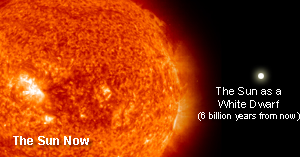|
|
White Dwarfs & Planetary Nebulas

A composite image of the Cat's
Eye from Chandra (purple) and HST (red & green) shows where the
hot, X-ray emitting gas appears in relation to the cooler material seen
in optical wavelengths.
|
A hundred million years after the red giant phase all of the star's available
energy resources will be used up. The exhausted red giant will puff off its outer
layer leaving behind a hot core. This hot core is called a Wolf-Rayet type star
after the astronomers who first identified these objects. This star
has a surface temperature of about 50,000 degrees Celsius and is furiously
boiling off its outer layers in a "fast" wind traveling 6 million kilometers per
hour.
The radiation from the hot star heats the slowly moving red giant atmosphere and creates a complex and graceful filamentary shell called a planetary
nebula (so called because it looks like the disk of a planet when viewed with a small telescope). X-ray images reveal clouds of multimillion degree gas that have been compressed and heated by the fast stellar wind. Eventually the central star will collapse to form a white dwarf star.
 In the white dwarf state, all the material contained in the star, minus the
amount blown off in the red giant phase, will be packed into a volume one
millionth the size of the original star. An object the size of an olive made of
this material would have the same mass as an automobile! For a billion or so
years after a star collapses to form a white dwarf, it is "white" hot with
surface temperatures of about twenty thousand degrees Celsius.
In the white dwarf state, all the material contained in the star, minus the
amount blown off in the red giant phase, will be packed into a volume one
millionth the size of the original star. An object the size of an olive made of
this material would have the same mass as an automobile! For a billion or so
years after a star collapses to form a white dwarf, it is "white" hot with
surface temperatures of about twenty thousand degrees Celsius.
When they were first discovered, white dwarfs presented a paradox to
astronomers. If a white dwarf couldn't produce energy through nuclear fusion, how
could it generate the pressure necessary to keep it from collapsing further? It
didn't seem possible, yet there they were, glowing dimly and reminding scientists
that "the fault is not in the stars, but in their theories," to paraphrase
Shakespeare.
|
 In the white dwarf state, all the material contained in the star, minus the
amount blown off in the red giant phase, will be packed into a volume one
millionth the size of the original star. An object the size of an olive made of
this material would have the same mass as an automobile! For a billion or so
years after a star collapses to form a white dwarf, it is "white" hot with
surface temperatures of about twenty thousand degrees Celsius.
In the white dwarf state, all the material contained in the star, minus the
amount blown off in the red giant phase, will be packed into a volume one
millionth the size of the original star. An object the size of an olive made of
this material would have the same mass as an automobile! For a billion or so
years after a star collapses to form a white dwarf, it is "white" hot with
surface temperatures of about twenty thousand degrees Celsius.